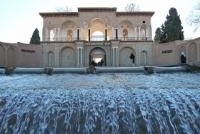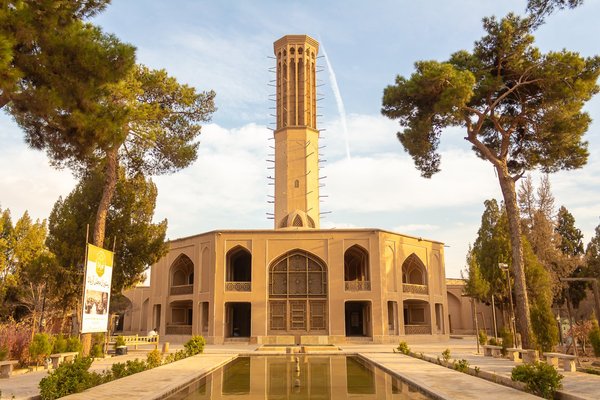Iran
Persian Garden
The Persian Garden comprises a set of gardens that have influenced garden design from Andalusia to India and beyond.
Persian Garden design is dominated by geometry and the use of water as a central element. They derive from the Chahar Bagh model: the division of a site into four sectors, opening out into the four cardinal directions. The site comprises nine gardens from different epochs and climates.
Community Perspective: You’ll likely come near one of these nine gardens when travelling in Central Iran. Bernard, who visited 3, found them “humble, modest and unpretentious gardens”, while Joyce, who managed 6, recommends not visiting in the wintertime.
Site Info
Official Information
- Full Name
- The Persian Garden (ID: 1372)
- Country
- Iran
- Status
-
Inscribed 2011
Site history
History of Persian Garden
- 2011: Inscribed
- Inscribed
- Type
- Cultural
- Criteria
- i
- ii
- iii
- iv
- vi
Links
- UNESCO
- whc.unesco.org
All Links
UNESCO.org
- whc.unesco.org — whc.unesco.org/
Official Website
News Article
- May 1, 2017 financialtribune.com — Funding for Restoration of Kashan's Fin Garden
Community Information
- Community Category
- Secular structure: Park or garden
- Cultural Landscape: Clearly defined
Travel Information
Exact locations inscribed twice (or more)
Red Zone Travel Advisory
Shiraz Hotspot
Isfahan Hotspot
Kerman Hotspot
Recent Connections
-
Red Zone Travel Advisory
Iran fully off-limits -
Foreigner prices
Bagh-e Fin: 30,000 Rials versus 200,000… -
Shiraz Hotspot
In town (Bagh-e Aram) and at Pasargadae
Connections of Persian Garden
- Trivia
-
-
WHS within walking distance
Isfahan city center -
Viewable from another WHS
Bagh-e Chehel Sotun is viewable from the backside of the tower of Ali Qapu away from Meidan
-
- History
-
-
Assassinations
In 1852 Amir Kabir, the Qajar Chancellor (widely considered to be "Iran's first reformer", a modernizer who was "unjustly struck down" as he attempted to bring "gradual reform" to Iran. As the prime-minister, he also ordered the killing of many Babis and the execution of the founder of the movement, the Báb), was murdered at the bath in the Fin Garden by an assassin sent by King Nasereddin Shah. See -See www.fouman.com
-
Achaemenid Empire
The legacy of the Persian garden throughout the Middle East and South Asia starts in the Achaemenid period, especially with the construction of Pasargadae by Cyrus the Great.See en.wikipedia.org
-
- Architecture
-
-
Chahar Bagh Gardens
All 9 gardens follow the "Chahar Bagh" lay-out. The Nomination file provides a detailed history of the concept and its religious and philosophical underpinning (E.g - "a form of garden which attempts to emulate Eden, (the four principal elements of sky, earth, water, plant) representing the world." ) -
Brick architecture
Shazdeh Garden: "Apart from the beauties of the garden, two-story mansions in the western and eastern parts of the garden perfectly represent Persian architecture. The main material used in them is brick (...)."
-
- Damaged
-
-
Destroyed or damaged by Earthquake
Bagh-e Shahzadeh (1981), Bagh-e Fin (1743)
-
- World Heritage Process
-
-
Exact locations inscribed twice (or more)
Also part of Yazd: Parsagadae garden, Dolat-abad Persian garden in Yazd. And of The Persian Qanat: the Hasan-e Mashir qanat runs through the Pahlavanpur Garden in Mehrez. -
Perfect Inscriptions
2011
-
- Religion and Belief
-
-
Zoroastrianism
"Symbolic of the creation of Eden as well as the four Zoroastrian elements of sky, earth, water and plants" (AB)
-
- Human Activity
- Constructions
-
-
Badgir
Bagh-e Dolat Abad
-
- Timeline
-
-
Built in the 6th century BC
Pasargadae complex with its garden (6th century BC) is exemplary in this respect and it was during this period that the main elements of the Persian Garden, namely Chahar Bagh, were laid down. (AB ev)
-
- WHS Hotspots
-
-
Shiraz Hotspot
In town (Bagh-e Aram) and at Pasargadae -
Isfahan Hotspot
Bagh-e Chehel Sotun in Isfahan city center -
Kerman Hotspot
Shazdeh nr Mahan
-
- Visiting conditions
-
-
Foreigner prices
Bagh-e Fin: 30,000 Rials versus 200,000 Rials -
Red Zone Travel Advisory
Iran fully off-limits
-
News
- financialtribune.com 05/01/2017
- Funding for Restoration of Kashan'…
Recent Visitors
Visitors of Persian Garden
- AC
- Adrian Turtschi
- Afshin Iranpour
- Alexander Barabanov
- Alexander Parsons
- A. Mehmet Haksever
- Ammon Watkins
- Artur Anuszewski
- Ask Gudmundsen
- Aspasia
- Atila Ege
- AYB
- Bamse
- BaziFettehenne
- Bernard Joseph Esposo Guerrero
- Bill Maurmann
- Carlo Sarion
- Chalamphol Therakul
- Christian Wagner
- Cirene Moraes
- David Marton
- Dimitrios Polychronopoulos
- DouglasR
- Eric Lurio
- Erik Jelinek
- Eva Kisgyorgy
- Fan Yibo
- Fmaiolo@yahoo.com
- George Gdanski
- Harald T.
- Harry Mitsidis
- henryjiao18
- Ivan Rucek
- Jacob Otten
- janis
- Jarek Pokrzywnicki
- Javier
- Jean Lecaillon
- John Smaranda
- Jonas Kremer
- Jon Opol
- Joyce van Soest
- Juha Sjoeblom
- Ken DJ
- Kevin247
- kiank37
- Knut
- LaVale
- Loic Pedras
- Maciej Gil
- Malgorzata Kopczynska
- marcel staron
- Martin
- Martina Rúčková
- Marton Kemeny
- MaYumin
- Mikko
- Miloš Tašković
- MoPython
- Morodhi
- Naim Y
- Nihal Ege
- Palimpsesto
- Patrik_globe
- Philipp Leu
- Reisedachs
- Rodinia
- Roger Ourset
- Roman Bruehwiler
- Sergio Arjona
- Solivagant
- Ssong.x
- Stanislaw Warwas
- Szucs Tamas
- Taotao Chen
- Tarquinio_Superbo
- Thomas Buechler
- Thomas van der Walt
- Timothy C Easton
- Tinamu
- Tony H.
- Westwards
- Wieland
- Wojciech Fedoruk
- Wo_ko
- Xander Huang
- Yongcheng Liu
- Zizmondka
- Zoë Sheng
Community Reviews
Show full reviews
During our Iran visit in May 2017, we ticked off three: Fin garden in Kashan, the ancient garden in Pasargadae, and Eram garden in Shiraz. We also had a fair glimpse of Chehel Sotun garden in Esfahan from its gates. However, after having seen India's Persian gardens earlier in 2015, which were adopted by the Moghuls using no less than Persian artisans, how should we appreciate the Persian gardens from the country where the tradition originated?
We visited Bag-e Fin on a Friday, which was not the best day to be a tourist in Iran since it is their weekend. Expecting tranquility and peace in the oldest functioning Persian garden in the world, what welcomed us was a garden fully packed with locals picnicking and groups occupying every known space inside. Sadly, knowing that we enjoy taking photos, the experience did not turn out the way we expected it to be. If there is any consolation, however, there was water flowing, all the fountains were working, the pools were not empty, and the water source, the Solomon's spring (a qanat opening that also feeds water to the T-Listed Tepe Sialk), can be publicly seen at the back. There were other attractions inside (ridiculously with separate entry fees!), but we no longer bothered giving them a try due to the long queues. Another thing that impressed me was that the garden is surrounded by thick and high mud walls typical in the desert region.
The 500BC-built ancient garden of Pasargadae is …
Keep reading 0 comments
All over Iran you can find beautiful gardens. Nine of them are inscribed on the list and I visited six of them.
To fully appreciate it, you should visit the gardens not in wintertime, which unfortunately I did. Most of the fountains in the gardens won't have water in it and the trees are mostly without leaves and there will barely be any flowers.
I did enjoy them nonetheless.
I first visited Bagh-e Eram in Shiraz. There was no water in the canals but the turquoise pond in front of the beautiful Eram palace and the surrounding palm trees from the Canary Islands were lovely.
Another one is in Pasargadae (a UNESCO site inside a UNESCO site). Since Pasargadae is an archaeological site, there is little left over from the garden. The only thing left from the garden is the outline of the watering canals.
The Bagh-e Shahzadeh (picture) in Mahan has a really nice long split-level fountain (fortunately there was water flowing, although I heard that a few weeks before my visit it was completely dry).
Only half of the Bagh-e Dolat Abad in the desert city of Yazd is open to the public, but it's still nice to visit, mostly because of the pavilion with the stain glass windows and the largest wind tower of the city (when you stand underneath it you can really feel the wind).
The Bagh-e Chehel Sotun in Esfahan has the palace I liked the most. It has amazing frescoes on the inside …
Keep reading 0 comments
